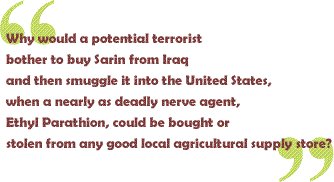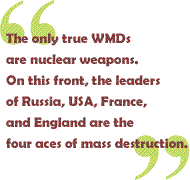
Invocation
of the words, "weapons of mass destruction" has
become key to Bushspeak. The President and his lieutenants
hurl the term with Biblical inflection as blanket justification
for all manner of foreign military adventures or domestic
political repression. In the mouths of Pirates, the acronym
"WMD" can mean a global plague that might kill millions
- or next to nothing.
George
Bush has transformed three letters of the alphabet into his
own tool of terror. He has discovered that Americans will
support instant death for anyone, anywhere, who can somehow
be linked to substances that might be described as potential
WMDs. Yet, nasty life forms and lethal chemical compounds
abound in the world - a near-universal resource. As we wrote
in our October 17 2002 commentary, "Permanent
War, Permanent State of Emergency," Bush has concocted
a blanket WMD excuse to use military force anyplace on the
planet.
This
logic, accepted by a majority of the Congress, can be applied
to the tiniest Caribbean or Pacific island nation, in conjunction
with any political grouplet thought to be located in any
corner of the world. Low-level germ stocks can be manufactured
in the smallest countries, and stolen or purchased by any
serious terrorist organization. No industrial base is necessary.
Under the Bush Doctrine, any nation accused of harboring
people who might possess such "weapons of mass destruction"
can be targeted and summarily neutralized. If capability
alone justifies attack, universal capability means worldwide
targets and permanent war.
Domestically,
Bush has only to invoke a WMD threat to drive the population
insane, a cover to detain anyone who might possess - or have
knowledge of others who might be interested in obtaining -
these ill-defined substances.
So,
what exactly are these potential WMDs? In this week's Guest
Commentary, Dwight Welch attempts to demystify the subject.
 No,
this is not another article about WMDs not being found or,
Was the war begun under a false pretext? Rather, I seek to
address a facet of this issue on technical grounds. First,
the only true WMDs are nuclear weapons. On this front, the
leaders of Russia, the USA, France, and England are the four
aces of mass destruction. Unfortunately, nerve gas and pathogens
also get grouped into this categorization. But examine the
facts: the atomic bombs of WWII instantly killed hundreds
of thousands of people. The Sarin gas attack on the Tokyo
subway system killed only 12 while sickening more than 5,000.
Hardly a comparison.
No,
this is not another article about WMDs not being found or,
Was the war begun under a false pretext? Rather, I seek to
address a facet of this issue on technical grounds. First,
the only true WMDs are nuclear weapons. On this front, the
leaders of Russia, the USA, France, and England are the four
aces of mass destruction. Unfortunately, nerve gas and pathogens
also get grouped into this categorization. But examine the
facts: the atomic bombs of WWII instantly killed hundreds
of thousands of people. The Sarin gas attack on the Tokyo
subway system killed only 12 while sickening more than 5,000.
Hardly a comparison.
Second,
nerve gas and pathogens are tricky to work with. They may
wind up killing the user. For instance, as the Iraqis discovered
in the Iran-Iraq war, these gases are heavier than air. Thus,
to their dismay, they discovered that nerve gas lobbed at
Iranian soldiers on a mountain top, did little to the Iranians,
but it settled back down into the valley where the Iraqis
were firing them from. Pathogens such as small pox may also
wind up infecting those employing such weapons, and rapidly
coursing through their own populations. As the anthrax attacker
found out, they can be tricky in other ways. He or she did
not anticipate that the dust was so fine that it passed through
the paper it was contained in, prior to reaching its destination.
Again, there were relatively few deaths considering its large
dispersal route, not mass destruction or mass death. Any military
expert worth his salt will tell you that nerve and bio agents
are ineffective weapons, not producing mass deaths, but mostly
mass fear. The mass fear, in this case, was generated not
by Iraq, but for a war which some of us regarded as being
unnecessary.
Third,
application of these agents coupled with their rapid rate
of breakdown in the environment does not lend itself to mass
destruction. Sarin readily breaks down in the presence of
water. The water knocks off the fluorine atom turning it into
a relatively low toxicity acid. Thus it would not do well
dumped into a reservoir, nor dispersed during this wet June
weather in Washington, DC. Consider the half-life of hours
for typical cholinesterase inhibitors (nerve gases, many insecticides)
in the presence of sunlight, compared to tens of thousands
of years half-life for plutonium. Cholinesterase inhibitors
break down notoriously fast, especially without a stabilizing
agent. The Iraqi defector who wrote a book about Saddam's
nuclear program has indicated that all of the cholinesterase
inhibitors not found by the UN inspectors when they were kicked
out in the late 90s have undoubtedly broken down by now. Biologicals
do not fare well in hot storage sheds either. Mustard agent
is an exception, having a shelf life of decades.
Another
disingenuous complaint is about Saddam using poison gas against
the Iranians and Kurds. Hello, this nerve gas was supplied
by the USA (the world's largest producer of nerve gas) under
the Reagan Administration. After Saddam gassed the Iranians
Donald Rumsfeld, now Secretary of Defense, recommended diplomatic
recognition of Saddam's regime, something he doesn't care
to discuss these days.
A
final consideration is this. Why would a potential terrorist
bother to buy Sarin from Iraq and then smuggle it into the
United States, when a nearly as deadly nerve agent, Ethyl
Parathion, could be bought or stolen from any good local agricultural
supply store? Sarin and EP have similar toxic effects according
to the Merck Index (a leading technical catalogue of toxic
substances), with Sarin being somewhat more toxic.
The
9/11 terrorists did not buy or receive airplanes from "terrorist
governments," they stole them locally. Bombs and bullets
are simple and the weapon of choice for terrorists. Tim McVeigh
used fertilizer for heaven's sake. Nerve gas and bio-agents
are high tech and difficult to use. A dirty bomb is a much
more likely scenario. But while the nuclear site in Iraq was
left unguarded for two and a half weeks (so much for the credibility
of Saddam being an imminent nuclear threat), as Iraqis dumped
the nuke isotopes on the ground so they could use the barrels
for storing water, some 20% of Saddam's nuclear inventory
disappeared. Please, there is no comparison between nuclear
weapons and nerve gas.

Was
the war worth it? Only time will tell. The intel on the WMDs
is now being seriously questioned, but even if Saddam was
hiding large stores of Sarin, they were unlikely to present
much of a danger to U.S. citizens.
Mr.
Welch is a Viet Nam veteran with 27 years at the Environmental
Protection Agency's Office of Pesticide Programs. The writer
is also president-elect of the union that represents EPA headquarters
scientists and engineers.
The
views presented here are those of the author and not his employer,
the EPA.


